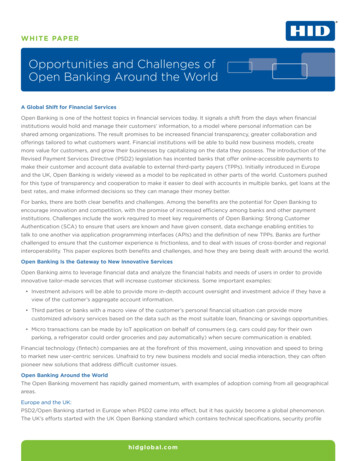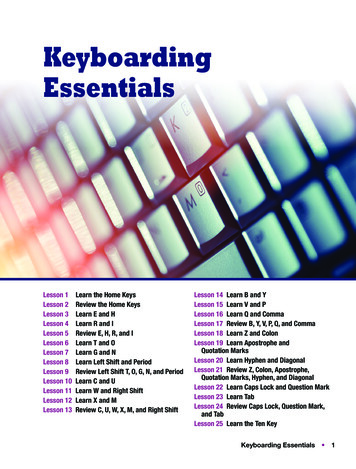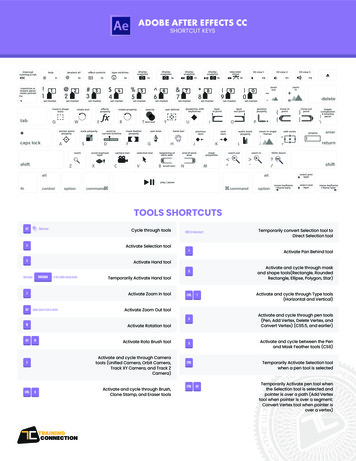
Transcription
W HI T E PA P E ROpportunities and Challenges ofOpen Banking Around the WorldA Global Shift for Financial ServicesOpen Banking is one of the hottest topics in financial services today. It signals a shift from the days when financialinstitutions would hold and manage their customers’ information, to a model where personal information can beshared among organizations. The result promises to be increased financial transparency, greater collaboration andofferings tailored to what customers want. Financial institutions will be able to build new business models, createmore value for customers, and grow their businesses by capitalizing on the data they possess. The introduction of theRevised Payment Services Directive (PSD2) legislation has incented banks that offer online-accessible payments tomake their customer and account data available to external third-party payers (TPPs). Initially introduced in Europeand the UK, Open Banking is widely viewed as a model to be replicated in other parts of the world. Customers pushedfor this type of transparency and cooperation to make it easier to deal with accounts in multiple banks, get loans at thebest rates, and make informed decisions so they can manage their money better.For banks, there are both clear benefits and challenges. Among the benefits are the potential for Open Banking toencourage innovation and competition, with the promise of increased efficiency among banks and other paymentinstitutions. Challenges include the work required to meet key requirements of Open Banking: Strong CustomerAuthentication (SCA) to ensure that users are known and have given consent, data exchange enabling entities totalk to one another via application programming interfaces (APIs) and the definition of new TPPs. Banks are furtherchallenged to ensure that the customer experience is frictionless, and to deal with issues of cross-border and regionalinteroperability. This paper explores both benefits and challenges, and how they are being dealt with around the world.Open Banking Is the Gateway to New Innovative ServicesOpen Banking aims to leverage financial data and analyze the financial habits and needs of users in order to provideinnovative tailor-made services that will increase customer stickiness. Some important examples: Investment advisors will be able to provide more in-depth account oversight and investment advice if they have aview of the customer’s aggregate account information. Third parties or banks with a macro view of the customer’s personal financial situation can provide morecustomized advisory services based on the data such as the most suitable loan, financing or savings opportunities. Micro transactions can be made by IoT application on behalf of consumers (e.g. cars could pay for their ownparking, a refrigerator could order groceries and pay automatically) when secure communication is enabled.Financial technology (fintech) companies are at the forefront of this movement, using innovation and speed to bringto market new user-centric services. Unafraid to try new business models and social media interaction, they can oftenpioneer new solutions that address difficult customer issues.Open Banking Around the WorldThe Open Banking movement has rapidly gained momentum, with examples of adoption coming from all geographicalareas.Europe and the UK:PSD2/Open Banking started in Europe when PSD2 came into effect, but it has quickly become a global phenomenon.The UK’s efforts started with the UK Open Banking standard which contains technical specifications, security profilehidglobal.com
W HITE PA P E R2and customer experience guidelines, and conformance and certification processes.i The movement quickly spread tothe Nordic countries, with Nordea opening its APIs to developers and offering pilot program access to real customerdata. Similar efforts are underway in Sweden, France, Poland, Spain and the Netherlands, as well across Europe viapan-European initiatives such as the Berlin Group, a European standards groupii .Asia-Pacific:Efforts to embrace Open Banking can be seen throughout the Asia-Pacific region, as many countries are preparingto implement open APIs. With a large population under the age of 30, an acceptance of new technology along witha willingness to look to fintech players for services, this region could rapidly embrace Open Banking. In the vanguardare Singapore, whose Monetary Authority is exploring an ASEAN-wide industry sandboxiii, the Hong Kong MonetaryAuthority, which is requiring Tier 1 banks to open their APIs, and South Korea which was the first country to launch acommon API infrastructure across financial institutions. Similar efforts are ongoing in Malaysia, China, South Korea,Thailand, Cambodia and Indonesia. In India, with digital identities for all citizens, a digital ecosystem to include OpenBanking APIs is being created.North America:Open Banking in North America operates under a more flexible set of directives and regulations. The regulatory systemthat governs fintech in the US is fragmented, with at least eight federal regulatory agencies having jurisdiction oversome portion of financial data access. The US Treasury Department has called for agencies to align behind the moveto allow US citizens to grant permission to their financial data. Recently, the US Consumer Financial Protection Bureaureleased its principles on data sharing and aggregationsiv , and several US banks have begun to develop open bankingportals and APIs.Latin America:Open Banking is taking hold across Latin America even without national or regional mandates. Mexico’s Open Bankinglaw encourages open APIs throughout the entire financial system, and projects are underway to develop an OpenBanking Standard—especially as it relates to API standardization.v The Central Bank of Brazil is designing an openbanking model that will allow clients to authorize their financial data to be accessed by banks, digital banks and fintechorganizations with interesting services to offer.Oceania:Australia has made a firm commitment to Open Banking, and all major banks will need to make banking data availableto consumers under a new open banking agreement with the federal government.vi In New Zealand, banks and fintechorganizations are joining in an Open Banking pilotvii.Africa:There is a growing financial technology market in Rwanda, and the National Bank of Rwanda has published aregulation to formalize the approach to mining and analyzing customer dataviii . In Nigeria, API standards are beingdeveloped for direct debit, ATMs, transaction history, bill payments and other use cases. Organizations such asAfrica’s Talking have already provided payment and communications APIs to help banks and financial technologyorganizations communicate with their customers across Africa.ix In South Africa, both innovative banks and fintechsare pushing the Open Banking trend.xStandardization Is a Global Agenda ItemOpen Banking APIs let banks and TPPs interact and share data more easily, giving customers the ability to managetheir finances through whatever means they want. While many one-off agreements have been inked, if banks are tocreate a full suite of financial services to offer customers, they will need to move to standardization across entireecosystems. This will allow for rapid growth of the ecosystem, while ensuring that APIs are secured from attacks—which are growing in number and severity, especially in cross-border transactions. Attempts are underway aroundhidglobal.com
W HITE PA P E R3the globe to achieve standardization, although still on a country-wide basis or across regions. In the UK, the OpenBanking Implementation Entity is working to design specifications for standardized APIs. The Entity was created bythe UK Competition and Monetary Authority (CMA) and is funded by the nine largest banks in the UK. We see similarbank consortium initiatives across Europe, including STETxi in France and the Berlin Groupxii (a consortium of more than45 players in the payment industry). The Swiss Open Financial API (SOFA) is dedicated to creating a common API andstandard for the Swiss financial services industryxiii. In the US, FS-ISACxiv, NACHA and the US Treasury Department aremoving toward standardization, while in Canada, the Canadian government is developing API playbooks.In the Asia-Pacific region, South Korea was the first country to launch a common API infrastructure across financialinstitutions.xv Efforts to create consistent APIs are underway in Australia, Hong Kong, Singapore, Japan and India, amongothers. The previously mentioned New Zealand Open Banking pilot is developing and testing two APIs, with the goal ofcoming to a consensus on common APIs.Trust Is the Foundation for Open BankingOne of the most important aspects of Open Banking is ensuring privacy and security. When a transaction takes place,the bank must be sure that the customer is who he/she claims to be and has provided consent for the third party toaccess his/her personal data. Allowing third parties to access customer accounts raises security and privacy concerns.Customers will use new services only if they trust that their data is secure. PSD2 addresses this with a requirement forStrong Customer Authentication on both sides of the transaction.In this growing ecosystem, authentication and identity management rest solely with the account-holding banks,which know the end users and will be in charge of authenticating them. Banks have, for years, understood the need toauthenticate users and sign transactions; they are parlaying this knowledge into building a secure environment aroundtheir APIs. The fundamental requirement is risk-based, frictionless authentication based on artificial intelligence (AI) andmachine learning to enable effective cyber threat and fraud detection. Deploying intelligent, data-driven authenticationhidglobal.com
W HITE PA P E R4methods can optimize the user experience by defining the appropriate level of authentication assurance to be applieddepending on the risk level of the user’s environment and transactions. To the extent this can be achieved with highlevels of security and an intuitive user experiences, it will create new growth opportunities for financial institutions.Open Banking Obstacles and OpportunitiesThe two principal challenges with Open Banking are being addressed in different ways and by different groups.Standardization of APIs is well underway but to date is only on a locally or regionally specific basis, with no realsynergies among different regions. Meanwhile, strong customer authentication remains the central element in the OpenBanking API ecosystem. It must be a priority bothfor banks— who already understand that sensitivedata requires high security and protection—andfor TPPs, who are just at the beginning of thelearning curve. The challenge of establishingand maintaining trust may be unusual forthem, as they are often not as security-savvyas banks; TPPs may err on the side of makingauthentication too easy (thus not robust) or toodifficult (leading to a poor consumer experience.)New entrants into the ecosystem are wise toleverage the brand identity and trust of the banksto ensure they don’t make mistakes that couldjeopardize customer security and privacy. At thesame time, banks can leverage startups’ innovation and openness to change as they expand their footprint and increasecustomer stickiness.Customer Confidence Will Energize GrowthOpen Banking is a global phenomenon and is rapidly impacting banks across the globe. It promises to enable banks tobecome more engaged and active with customers by providing or facilitating a variety of new services and products.While issues related to standardization are being worked out, we can’t lose sight of the fact that the bedrock is trust.As financial fraud incidents grow in digital banking channels, it is imperative that institutions protect their customers.This includes securing their browsers, devices and applications while ensuring each transaction can be trusted, frommoney transfers to adding a beneficiary or requesting a new loan. These requirements are driving a new approach tomulti-factor authentication that is based on machine learning and artificial intelligence, allowing organizations to makesmarter real-time risk-mitigation decisions while cutting operational costs and reducing fraud-related losses.HID Global enables financial institutions to provide peace of mind to customers by ensuring that shared customerdata remains fully secure. The increased level of trust provided by HID Global solutions can lead to greater customeracquisition and retention and make users feel more confident about taking advantage of the full range of new innovativeservices.For more information visit hidglobal.com/trusted-transactionshidglobal.com
W HITE PA P E pliance-with-final-rts-on-sca.html?listestart korea-is-launching-an-open-banking-platform-2016-8 2019 HID Global Corporation/ASSA ABLOY AB. All rights reserved. HID,HID Global, the HID Blue Brick logo, the Chain Design are trademarks orregistered trademarks of HID Global or its licensor(s)/supplier(s) in the USand other countries and may not be used without permission. All othertrademarks, service marks, and product or service names are trademarksor registered trademarks of their respective nges-wp-enAn ASSA ABLOY Group brandPLT-04278
2 and customer experience guidelines, . In the vanguard are Singapore, whose Monetary Authority is exploring an ASEAN-wide industry sandboxiii, the Hong Kong Monetary Authority, which is requiring Tier 1 banks to open their APIs, and South Korea which was the first country to launch a . multi-factor authentication that is based on machine .











